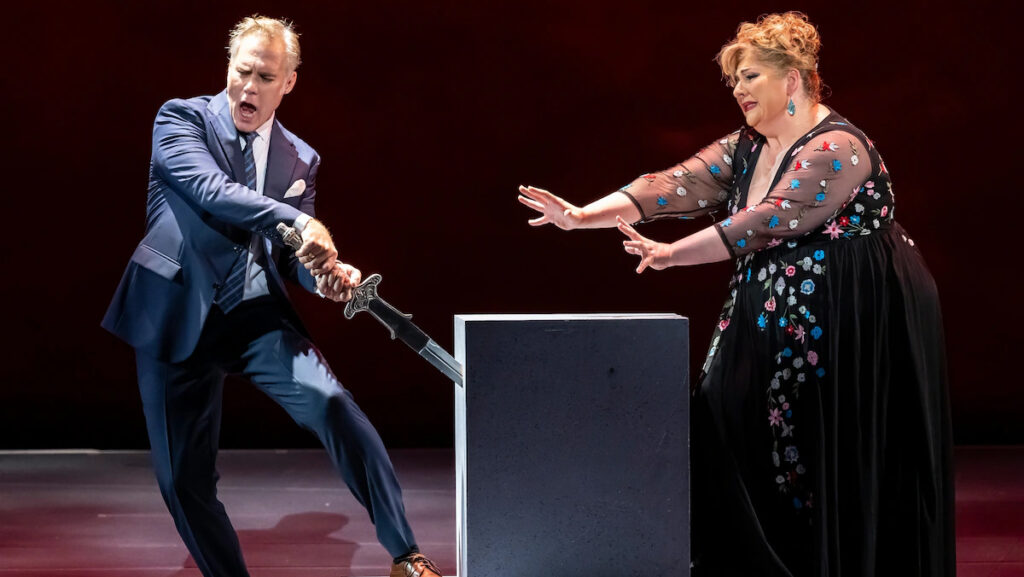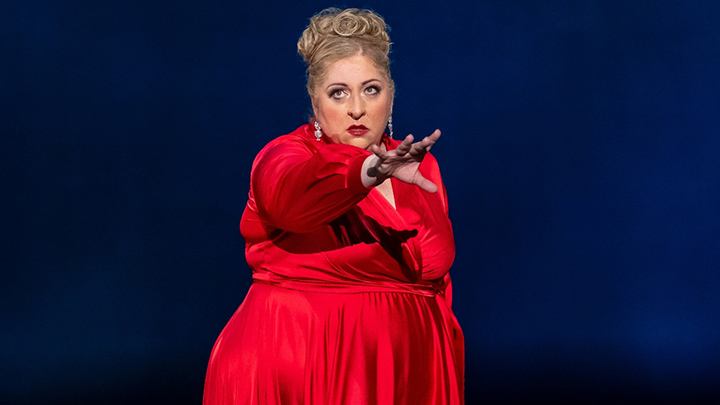WNO hasn’t produced a work of Wagner’s since the complete cycles of Francesca Zambello’s “Ring” presented in the spring of 2016, led by former WNO music director Philippe Auguin. Between the retrenchment after that massive project, Auguin’s departure, and the pandemic, Wagner at the Kennedy Center has seemed like a dim possibility in the intervening years. If WNO’s goal was get D.C. audiences excited for Wagner’s return to the opera house, this presentation of leading interpreters in a review heavy on the greatest hits did the trick, some scrappy edges notwithstanding.
New WNO Music Director designate Robert Spano, back at the podium after leading Fidelio, is no stranger to this music, having led complete Ring Cycles in Seattle in the 2000s among other assignments. The likely candidate to helm any high profile production of a Wagner should we get one during his tenure, he had mixed success in this outing, starting with the opening selection of the overture to Rienzi. Initial material around the main theme had a suitable stateliness, with precise work in the strings’ ascending figures making up for a tough pass on the exposed trumpet line. But the exuberant march sections had a plodding marching band character and the transitions between sections seemed to sap momentum instead of increasing excitement.
Australian bass-baritone Derek Welton, also appearing as Pizarro in the concurrent Fidelio, next offered the Dutchman’s introductory scene from Der Fliegende Holländer. Welton sounded more vocally comfortable here than in his Pizarro the previous night, with an attractive, flexible sound and thoughtful attention to the text. If his stage presence couldn’t quite capture the Dutchman’s titanic rage, Spano’s sure sense of the roiling orchestral material underneath made up some of the deficit.

The evening’s Ring selections began with Die Walküre Act I, from “Wintersturme” through the curtain, featuring Christine Goerke and Brandon Jovanovich as the sibling-lovers. Goerke’s recent foray into Sieglinde in a handful of concert settings is a delightful twist at this juncture. Her inclination to find the innocence and vulnerability in her characters, a drawback for some in her Brunnhildes and Elektras, is a sure fit for Sieglinde. She sounded exceedingly comfortable in her upper register here, with a spinning unencumbered sound, though delving into the middle voice she notably lost volume before re-emerging with more solid chest tones.
Jovanovich doesn’t have the ringing tone and sweetness for “Wintersturme” he once did, but it is a sound that is aging gracefully, with a heroic heft and vocal charisma to spare. His years of experience with this role leapt off the stage, in a facility with the text and sense of how to build Siegmund’s music to its apotheosis. Spano and the orchestra tracked the building tension closely though perhaps at the cost of some scrambling in the winds and strings.
Overall there was just an undeniable charm about the scene with these two veterans, dressed in concert attire and wigless, selling some of Wagner’s most naive and (sort of) innocent love music. (Someone please write an elaborate framing device for one of these excerpt concerts about how they’re knocking down the Festspielhaus tomorrow and the gang of old Wagnerians has assembled one last time to stumble through an act or two and lie about themselves a little.)
Derek Welton returned for Wotan’s farewell from Die Walküre Act III, a role he debuted earlier this year at Deutsche Oper Berlin in Stefan Herheim’s production. His smooth ringing baritone is captivating in Wotan’s most lyrical passages, especially a melting “Der Augen Leuchtendes Paar,” though one wonders if he can summon more vocal edge to round out the character in the theater. The critical orchestral interlude between Wotan’s sections was underwhelming here, the pit seemingly in accompaniment-only mode for this number.

A palate cleanser between Ring courses, the prelude to Act III of Lohengrin got off to a spirited start but was marred by some less than precise feverish sawing in the strings and an impressive but excessive horn fanfare. At the same time, the gentle section anticipating the wedding march felt rushed and didn’t achieve the change in character necessary to really set off the return of the fanfare material.
Goerke and Jovanavich reunited for the end of Siegfried Act III, beginning with “Ewig war ich.” Jovanovich gamely undertook a Siegfried here with the assistance of sheet music, demonstrating a nice sturdy sound but not able to really own the music in the more involved passages. Back on more familiar territory, Goerke’s voluptuous middle voice made a welcome return, while her top was generally steely and secure minus a few of the very top notes, including an undercooked final C.
A “Ride of the Valkyries” excerpt up to Brunnhilde’s arrival opened the second half, probably obligatory from a programming standpoint but in practice a bit anticlimactic as the Hojotohos devolve into a lot of shop talk about horses before it just peters out. There was substantial variation across the Walküren pick-up crew of WNO young artists.
Former WNO young artist and mainstay of the 2016 Ring production, Solomon Howard, offered an interesting curio next: the aria “Norma il predisse, o Druidi” that Wagner composed as an addition for Oroveso in Normaafter Bellini’s death. (Perhaps the 19th century version of writing your own Murphy Brown.) Solmon’s cavernous sound easily filled the house with appeals to the Druids though he strained a bit at the lowest points.
The balance of the evening was devoted to Götterdämmerung, beginning with a Siegfried’s Rhine Journey orchestral excerpt that had a lively flow and light, well-balanced textures across sections. Jovanovich returned for a restrained and touching turn in Siegfried’s death scene, followed by the Funeral March, perhaps the best orchestral excerpt of the evening, with plenty of excitement in the shuddering horn blasts.
Goerke closed things out with a commanding and poignant Immolation Scene. Tender reflections about Siegfried were infused with a nobility and warmth and the sprint from “Fliegt Heim ihr Raben” to the end was exhilarating, Goerke pouring out waves of ecstatic sound. As with the Siegfried excerpt a few of the very top notes could pinch. But overall this was a shiver-inducing finale.
Francesca Zambello directed the lightly staged scenes on the simple catwalk set used by Fidelio. A series of projections (designed by S. Katy Tucker and Kylee Loera), were used to enhance the orchestral interludes which very well may have been dusted off from the 2016 productions but in any event were in the same vein. These were largely unobtrusive save for the ridiculously happy blue sky and tree at the end of theGötterdämmerung finale which seemed excessively upbeat for a world cleansed by fire just 90 seconds ago.
Photos: Scott Suchman






Comments